汉译英技巧-主语的选择
- 格式:ppt
- 大小:233.00 KB
- 文档页数:10


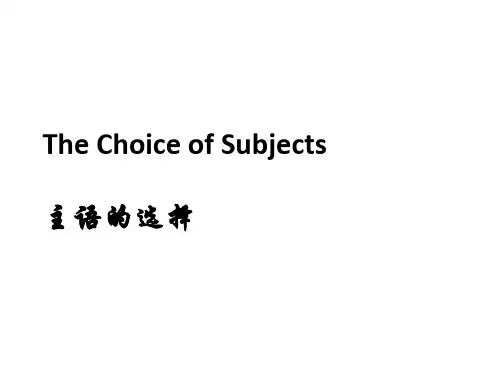

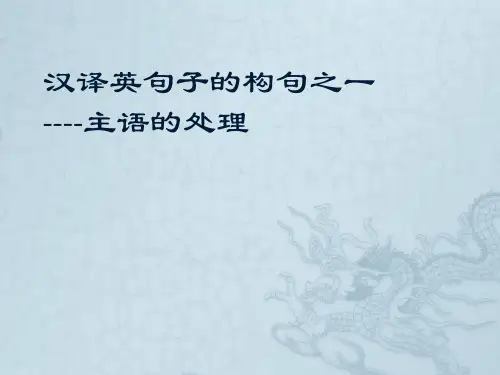
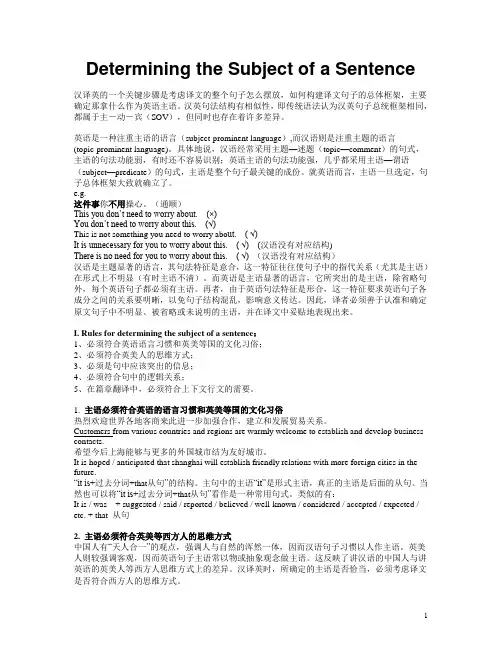
Determining the Subject of a Sentence汉译英的一个关键步骤是考虑译文的整个句子怎么摆放,如何构建译文句子的总体框架,主要确定那拿什么作为英语主语。
汉英句法结构有相似性,即传统语法认为汉英句子总统框架相同,都属于主-动-宾(SOV),但同时也存在着许多差异。
英语是一种注重主语的语言(subject-prominent language),而汉语则是注重主题的语言(topic-prominent language)。
具体地说,汉语经常采用主题—述题(topic—comment)的句式,主语的句法功能弱,有时还不容易识别;英语主语的句法功能强,几乎都采用主语—谓语(subject—predicate)的句式,主语是整个句子最关键的成份。
就英语而言,主语一旦选定,句子总体框架大致就确立了。
e.g.这件事你不用操心。
(通顺)This you don’t need to worry about. (×)You don’t need to worry about this. (√)This is not something you need to worry abo ut. ( √)It is unnecessary for you to worry about this. ( √) (汉语没有对应结构)There is no need for you to worry about this. ( √) (汉语没有对应结构)汉语是主题显著的语言,其句法特征是意合,这一特征往往使句子中的指代关系(尤其是主语)在形式上不明显(有时主语不清)。
而英语是主语显著的语言,它所突出的是主语,除省略句外,每个英语句子都必须有主语。
再者,由于英语句法特征是形合,这一特征要求英语句子各成分之间的关系要明晰,以免句子结构混乱,影响意义传达。
因此,译者必须善于认准和确定原文句子中不明显、被省略或未说明的主语,并在译文中妥贴地表现出来。

英汉互译中对主语的处理英汉互译是指将英文语言转换成中文语言或者将中文语言转换成英文语言的过程,它是外语学习与文学交流首要工具之一,也是桥梁与纽带,能够将两种不同文化异彩斑斓。
在英汉互译中,主语的处理是十分重要的,由英汉句子结构可以看出,两种语言的主宾句法有较大差异,因此,在英汉互译时应当正确把握主语的位置。
一、英译汉时注意主语的处理1、主语用it代替当出现复杂的复合句时,为了简化译文,可以用it作形式主语来代替真正的主语,这就需要注意,形式主语所作行为是否与真正主语完全一致。
2、名词性状语作表语当状语的位置在主语的前面时,可以用名词性的形容词来作表语,但在此种情况下,要注意,在换译后的句子中文字的位置应当与原句的排列一致。
3、主语的物主代词可以删去在英汉互译中,英语中的物主代词可以删去,直接用名词作主语,把英语中的物主代词省略掉,即可节约篇幅,使汉语句子简洁、亲切。
二、汉译英时注意主语的处理1、直接将汉语主语对应一个英文名词作主语汉译英时,可以直接将汉语中的动词或有生命的主语,对应英语中一个名词作为句子的主语,以简化译文,汉语中有生命的主语,也可以译成英语中的一个名词作为句子的主语,但是译成的英文要注意保持原意,而不能出现歧义。
2、不定式汉译英时,有时不定式也可作英文句子的主语。
当汉语中的主语是动词时,我们可用不定式作主语,可以使句子的表达更加准确,而且更加简洁明快。
3、省略主语汉译英时,可以将主语省略,凡是句子无必要强调或者已知语境中得出结论时,可以将主语省略,但这种情况只限于那些可以由读者自行推测出所提及的事物时。
以上是英汉互译中对主语处理的相关内容,从中可以看出,英汉互译当中,主语的处理是十分重要的,只有正确把握其语义,才能准确地体现出句子的意思,从而使英汉互译更准确。
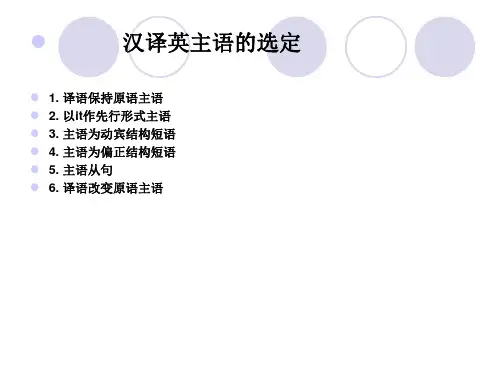
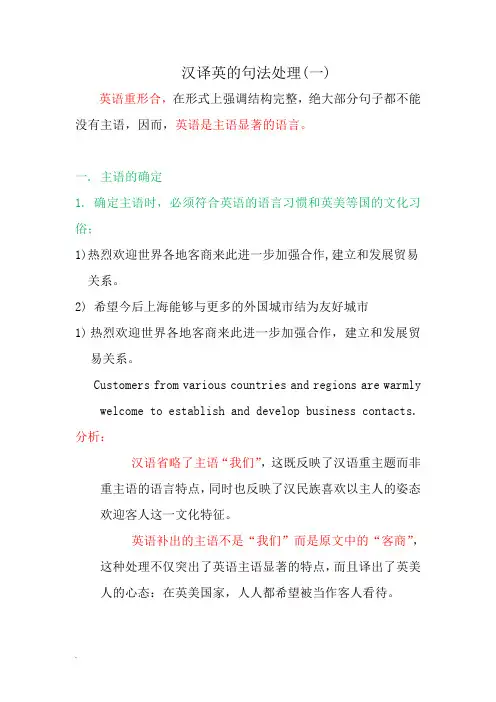
汉译英的句法处理(一)英语重形合,在形式上强调结构完整,绝大部分句子都不能没有主语,因而,英语是主语显著的语言。
一. 主语的确定1. 确定主语时,必须符合英语的语言习惯和英美等国的文化习俗;1)热烈欢迎世界各地客商来此进一步加强合作,建立和发展贸易关系。
2) 希望今后上海能够与更多的外国城市结为友好城市1)热烈欢迎世界各地客商来此进一步加强合作,建立和发展贸易关系。
Customers from various countries and regions are warmly welcome to establish and develop business contacts. 分析:汉语省略了主语“我们”,这既反映了汉语重主题而非重主语的语言特点,同时也反映了汉民族喜欢以主人的姿态欢迎客人这一文化特征。
英语补出的主语不是“我们”而是原文中的“客商”,这种处理不仅突出了英语主语显著的特点,而且译出了英美人的心态:在英美国家,人人都希望被当作客人看待。
2) 希望今后上海能够与更多的外国城市结为友好城市。
It is hoped/anticipated that Shanghai will establish friendly relations with more foreign cities in the future.分析:汉语省略了主语“我们”或是“人们”。
为了避免这种指代不清,英语中有一种左右逢源的办法,即使用“It is +过去分词+that从句”的结构。
2. 确定主语时,必须符合英美人的思维方式;1)她从来没想到他是个不诚实的人。
1)她从来没想到他是个不诚实的人。
It never occurred to her that he was a dishonest man.分析:译文中,主语是“It”,这是西方人的思维方式,译文意为:这种念头从来没有闪过她的脑际。
这种翻译强调了“他是个不诚实的人”这一客观事实,并显露出她对之一事实感到惊讶。
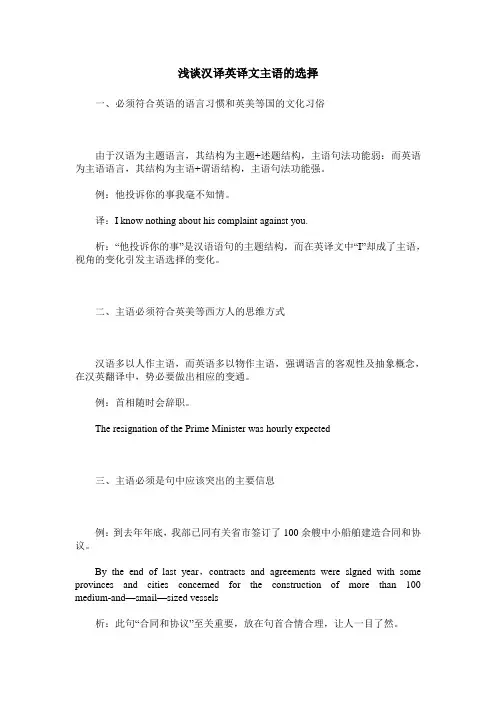
浅谈汉译英译文主语的选择一、必须符合英语的语言习惯和英美等国的文化习俗由于汉语为主题语言,其结构为主题+述题结构,主语句法功能弱:而英语为主语语言,其结构为主语+谓语结构,主语句法功能强。
例:他投诉你的事我毫不知情。
译:I know nothing about his complaint against you.析:“他投诉你的事”是汉语语句的主题结构,而在英译文中“I”却成了主语,视角的变化引发主语选择的变化。
二、主语必须符合英美等西方人的思维方式汉语多以人作主语,而英语多以物作主语,强调语言的客观性及抽象概念,在汉英翻译中,势必要做出相应的变通。
例:首相随时会辞职。
The resignation of the Prime Minister was hourly expected三、主语必须是句中应该突出的主要信息例:到去年年底,我部已同有关省市签订了100余艘中小船舶建造合同和协议。
By the end of last year,contracts and agreements were slgned with some provinces and cities concerned for the construction of more than 100 medium-and—smail—sized vessels析:此句“合同和协议”至关重要,放在句首合情合理,让人一目了然。
四、根据上下文正确的逻辑关系确定主语1原文形容词性成分为译文主语例:懒惰的人不会成功。
Laziness makes success impossible.析英美人则强调客观,不妨取形容词“懒惰”为主语,更符合英美人的思维方式。
2、选原文的名词性成分为译文主语例:他突然发现地毯上有个污点。
A dark stain on the carpet caught his eyes.没有用原句中的代词作主语,而用名词为译文主语,符合英语的语言特色。
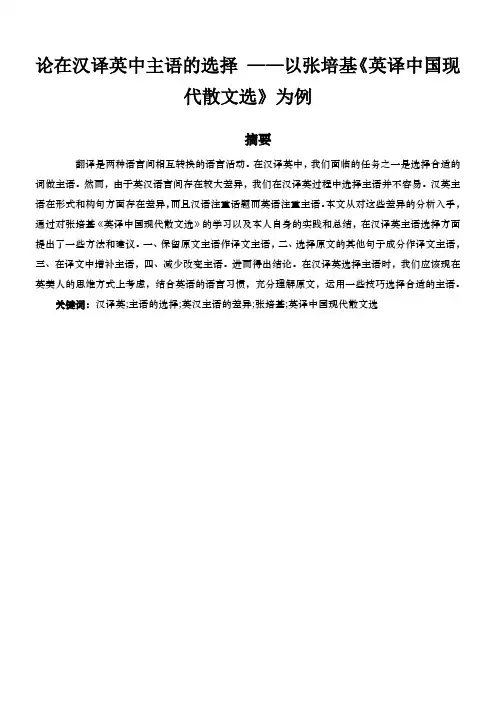
论在汉译英中主语的选择——以张培基《英译中国现代散文选》为例摘要翻译是两种语言间相互转换的语言活动。
在汉译英中,我们面临的任务之一是选择合适的词做主语。
然而,由于英汉语言间存在较大差异,我们在汉译英过程中选择主语并不容易。
汉英主语在形式和构句方面存在差异,而且汉语注重话题而英语注重主语。
本文从对这些差异的分析入手,通过对张培基《英译中国现代散文选》的学习以及本人自身的实践和总结,在汉译英主语选择方面提出了一些方法和建议。
一、保留原文主语作译文主语,二、选择原文的其他句子成分作译文主语,三、在译文中增补主语,四、减少改变主语。
进而得出结论。
在汉译英选择主语时,我们应该现在英美人的思维方式上考虑,结合英语的语言习惯,充分理解原文,运用一些技巧选择合适的主语。
关键词:汉译英;主语的选择;英汉主语的差异;张培基;英译中国现代散文选AbstractTranslation is a language activity of transforming between two languages. In the process of Chinese-English translation, choosing the suitable words as subjects is one of the tasks people facing with. However, it's not easy for people to choose subjects in Chinese-English translation because of the differences between Chinese and English. The subjects of Chinese and English have differences in forms and sentence structure. Furthermore, Chinese is topic-prominent language and English is subject-prominent language. This thesis begins with these differences, puts up some methods and advises about how to choose a suitable subjects through learning Selected Modern Chinese Essays by Zhang Peiji and the author own practices and conclusion. First, keeping the subjects of the original sentences. Second, choosing other constituents of the original sentences. Third, replenishing new subjects for the translation. Fourth, reducing of changing the subjects. And then, the writer shows the conclusion that it should be considered the mode of thinking in western countries, combining with the English language habits, fully understanding the origin text, and use some skills to choose the appropriate subjects.Key words: Chinese-English Translation;the choice of subjects;the differences of subjects in English and Chinese;Zhang Peiji;Selected Modern Chinese EssaysContentsAbstract (I)1.Literature Review 01.1 Existing Researches on this Topic 01.2 Purposes and importance of the study 02. Differences between Chinese and English Subjects (1)2.1 In Forms (1)2.2 Topic-prominent Language vs. Subject-prominent Language12.3 In Sentence Structure (2)3. Methods of Choosing the Subjects in Chinese-English Translation 23.1 Keep the Subjects of the Original Sentences (3)3.2 Choose other constituents of the Original Sentences (3)3.2.1 Choose the Objects to be the Subjects (4)3.2.2 Choose the Adverbials to be the Subjects (4)3.2.3 Choose the Attributives to be the Subjects (6)3.2.4 Choose the Predicates to be the Subjects (6)3.3 Replenish New Subjects for the Translation (6)3.3.1 Replenish the Suppressed Subjects of the Original .. 73.3.2 Replenish the Impersonal Pronoun “It” (7)3.4 Reduce of Changing the Subjects (8)4. Conclusion (9)Bibliography (10)Acknowledgements (10)1.Literature Review1.1 Existing Researches on this TopicMany scholars discussed the translation of Chinese and English sentences from the perspective of differences between Chinese and English subjects. According to the existing research, there are many different forms of expression between Chinese and English, which can be divided into topic-prominent language and subject-prominent language, covert subject and overt subject, parataxis and hypotaxis in sentence structure, personal subject and impersonal subject. These studies focus on the analysis of subjective differences between Chinese and English languages, but the discussion of subjects in Chinese-English translation is relatively less detailed. In the book Chinese-English Translation Studies and Practice written by Ji Dequan (2005: 105), who puts forward five principles of determining the subjects in Chinese-English translation: "(1) It must conform to the English expression and the background. (2) It must conform to the English way of thinking ". (3) It must be the information that should be emphasized in the sentence. (4) It must follow the logical order of the sentence. (5) It should meet the context of the request ". In addition, Liu Miqing (1992: 37:46) has concluded in his book Contrast and Translation of English and Chinese three specific methods of selecting the subjects in the procession of translating Chinese into English, which are equivalence, shift, and supplement. These studies provide translators with some theories, principles, and strategies to choose the subject of Chinese to English translation.1.2 Purposes and importance of the StudyThe main purposes and importance of my paper can be summarized as the following two aspects. First of all, as a famous translator and translation theorist, Zhang Peiji made a great contribution to the translation of Chinese papers. The qualities and standards of the articles which he translated are very high. His Selected Modem Chinese Essays was widely accepted by readers and scholars to help spread the Chinese culture, so his translation of the paper worthy of translators’ unremitting study, they learned a lot, so as to improve translators’ ability to translate; the other aspect is that there is no denying the important role of the subject in shaping and constructing sentences in both Chinese and English. They also have a significant impact on the cohesion of sentences,but because of the differences between English and Chinese subjects, translators choose an appropriate subject from Chinese into English as a challenge, so it seems that it should be investigated and made detailed use of some useful translation techniques and strategies to help translators’ determine the subject of Chinese to English translation. Zhang Peiji's Chinese prose translation has set a good example in choosing the appropriate subject, so the author chose to analyze own translation works together with him and explore the method of choosing the subject.2.Differences between Chinese and English SubjectsChinese and English belong to two different language families, therefore Chinese finds its root in the Sino-Tibetan Language Family, while English belongs to Indo-European Language Family. Differences exist between the two languages, one of which is the difference between their subjects, so as bring difficulties to us in English learning and Chinese and English translation. This chapter will generally discuss the differences between Chinese and English subjects mainly in the following three facts.2.1 In FormsChinese subjects are diverse and highly compatible. Wei Zhicheng (2003) points out that all kinds of words, phrases and clauses can be used as Chinese subject. Liu Miqing (1992) argues that, due to the diversity of Chinese characteristics, the Chinese language features, almost any form of expression can be directly used as the subject of Chinese, or in other words, topics, such as nouns, verbs, adjectives, quantifiers or any other words, phrases or terms, we consider them to be "topics" rather than "subjects". “TmS (time subject), PlS (place subject), DaS (subject matter), MrS (modifier subject) Chinese subject” (Liu Meiqing, 1992: 39). Unlike Chinese subjects, English subjects are less incompatible and form singular, because they must be nominal. Thus, noun and subject pronouns can be used as subject of English, and as for other non-nominal words, phrases or clauses, if you want to use them as subjects of English, you must change their form and make them nouns.2.2 Topic-prominent Language vs. Subject-prominent LanguageAccording to Li and Thompson (1976) theory, different languages can be divided into four categories, namely the subject-prominent language, thetopic-prominent language, both the subject-prominent and the topic-prominent language, neither the subject-prominent nor the topic-prominent language. And they show that Chinese belongs to the topic-prominent language which is the informational units of topic and comment that are basic to the structure of sentences, while English is the subject-prominent language which is the grammatical units of the subject and predicate that are basic to the structure of sentences. English focuses more on the relationship between the subject and the actor and the action, and the performance of the behavior can be found in the close grammatical relationship between the English subject and the predicate. This is not the same as Chinese. Zhao Yuanren (1979) said that only about 50% of the relationship between the Chinese subject and the predicate reflects the relationship between the actor and the behavior, so it is best to be the Chinese subject and predicate as the topic and comment. This also explains why Chinese subjects are more diverse than English subjects.2.3 In Sentence StructureFrom the above discussion, you can conclude that that English emphasizes the subject. They are indispensable in constructing sentences. In most cases, the subject is the starting point, the center and the must in English sentences. Often using the formal subject "it" can also be a good explanation of the English subject is indispensable. They have a decisive grammatical function and have a comprehensive and close relationship with the whole sentence. In English, the subject decides the number of predicates, so it should be consistent with the subject when the sentence is constructed. “The main body and the predicate form the seven main English sentences, namely SV, SVC, SVO, SVA, SVOO, SVOC, SVOA.” (Quirk, R., Greenbaum, G. Leech & J. Svartvik, 1985: 721). These forms of sentences also reveal the importance of English subjects. Chinese sentences are more flexible and do not have to follow strict sentences as English. As for the Chinese subject, they are not indispensable in the sentence structure and are not related to the form of the predicate. No subject sentences are common to meet in Chinese, and in many cases the subject can be omitted.3.Methods of Choosing the Subjects in Chinese-English Translation3.1 Keep the Subjects of the Original SentencesFrom the analysis and discussion in section two, translators understand that the subject of English sentences is mainly nouns, subjective pronouns or nominal words. If the original Chinese has a clear subject, and the subject is composed of nouns or subjective pronouns, and in line with the English primitive order, which is the thematic progression pattern. And then the translation of the original subject can be used as the subject of English translation. This is the easiest and most reliable means of choosing a subject in Chinese to English translation.(1)这激流永远动荡着,并不曾有一个时候停止过,而且它也不能够停止;没有什么东西可以阻止它。
主语的选择①名词特性②搭配合理③主题突出④注意尾重⑤注意连贯①名词特性主语必须是名词,包括名词短语,名词性从句,也包括具有名词特性的-ing分词,动词不定式to do全球发展不平衡加剧。
Imbalance in global development has widened.求和平、谋发展、促和平已经成为各国人民的普遍愿望。
To promote peace, development and cooperation has become the shared aspiration of people across the world.建设生态文明,是关系人民福祉、民族未来的长远大计。
Promoting ecological progress is a long-term task of vital importance to the People’s well-being and China’s future. (to do 也可以)②搭配合理上海豫园的九曲桥,景随步移,美不胜收,旅游小册子中有这样一句话:每一次转折都会看到不同的景色。
Every turning can see/admire/enjoy a different view. ???转折做主语吗?中文是话题为主的,汉语看上去是主语,实际在英文中不过是时间,是地点或是状语。
唐朝出现了真正意义上的中国传统园林建筑。
园林出现了在唐朝。
Traditional Chinese architecture in a real sense first emerged/appeared in the Tang Dynasty.宋朝发明了活版印刷术。
③主题突出第四十一届世博会规模为历届之最。
The scale of the 41st World Expo is the biggest of its kind???The 41st World Expo is the biggest of its kind in scale.中国古典园林规模大小不等。